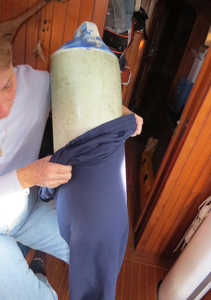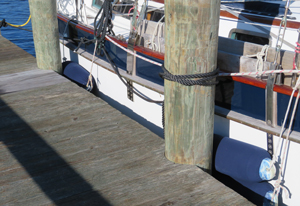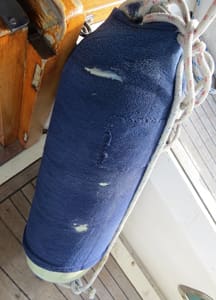Fenders, as most sailors know, act as bumpers to keep your boat off the dock and prevent its hull from being scratched or chafed by whatever protrudes from the dock, like cement or wood pilings. Covering fenders is partly cosmetic — they look better — and partly to keep the fenders themselves from rubbing and scuffing the hull.
Our Liberty 458 Nine of Cups was in desperate need of some replacement fender covers. I searched online for either a pattern or instructions. It was David, however, who found mention of a solution on a sailing forum that made so much sense and was so easy that I’m sorry I didn’t think of it myself.
There are pros and cons to using fender covers. Some argue that the cover fabric, usually fleece, attracts dirt, grime and salt, and increases the likelihood of scratching the topsides. Others, like us, find them quite useful in protecting the new paint job on our topsides. Our last fender covers, or fender boots as they are sometimes called, were purchased in Australia and they never fit quite right, not to mention they were looking pretty ratty. I’d repaired a couple of chafe spots in the past, but their current condition was beyond repair. It was time for something new.
I found new fender covers online for about $40 each in the size that would fit our fenders. We needed three of them, but $120 for fender covers was not in our budget. I looked for a pattern online and found some how-to directions, but none seemed all that reasonable or affordable. Following up on David’s lead, I discovered several mentions on sailing threads that suggested using sweatpants as fender covers. Brilliant!
 |
|
Measuring the fender. |
Here’s how:
1. Measure the circumference and length of the fender to be covered.
2. You can make two fender covers from each pair of sweatpants. Purchase sweatpants in your choice of color(s) at a thrift shop or discount store, e.g. Walmart, with the following criteria: The width of the pant leg multiplied by two should approximately equal the circumference of the fender. For example, the circumference of our largest fender was about 29 inches. We chose size 3XL sweatpants (14.25 inches wide) for it, and a 2XL was large enough for two slightly smaller fenders. Remember, the pants have a bit of stretch and the final fit needs to be snug. Measure the length up to the crotch of the sweatpants to be sure the leg is long enough, and make sure the pants are elasticized at the leg cuffs.
3. Stuff a fender into a pant leg as far as it will go. It should be a snug fit, and the attachment ring on the end of the fender should be exposed.
4. Measure the length, allowing for a 1-inch seam at the crotch end, and mark accordingly. Remove the fender and make the cut.
 |
|
Fitting the new covers. |
5. Stitch along the cut edge, forming a 1-inch tube through which you can draw a small length of line.
6. Make a small cut in the tube and insert a piece of line attached to a safety pin (or paper clip) and work the line into the tube, drawing it through as you go until it meets the other end of the line. Then, “butane whip” the ends of the line with a lighter to keep them from unraveling.
7. Slip the cover back onto the fender, drawing it up snug and tight from one end to the other. The elastic cuff will keep one end in place.
8. Cinch the drawn line tight on the other end. Tie a knot and tuck it inside the fender cover.
9. Attach lines to the fender attachment rings as you normally would and make fast to the boat.
Voila! A customized fender cover that looks great and protects the hull. The only maintenance required is periodic laundering. Hint: If you don’t drag your fenders in the water, you won’t have to wash them as frequently.
 |
|
The new fender covers in place, keeping Nine of Cups off a dock. |
The total cost comes to about $4.00 per fender cover, factoring in the sweatpants from Walmart ($7.36 each plus local tax, makes two fender covers), a bit of thread, about 18 inches of small line and 20 minutes of my time.
We good old boat women are very budget-conscious and handy to have around.
Marcie Connelly-Lynn and her husband David have lived aboard Nine of Cups, a 1986 45-foot Liberty cutter, since 2000 and have sailed more than 65,000 nautical miles. “Nine of Cups” is a tarot card signifying “dreams come true.” You can check out their website at www.nineofcups.com.

